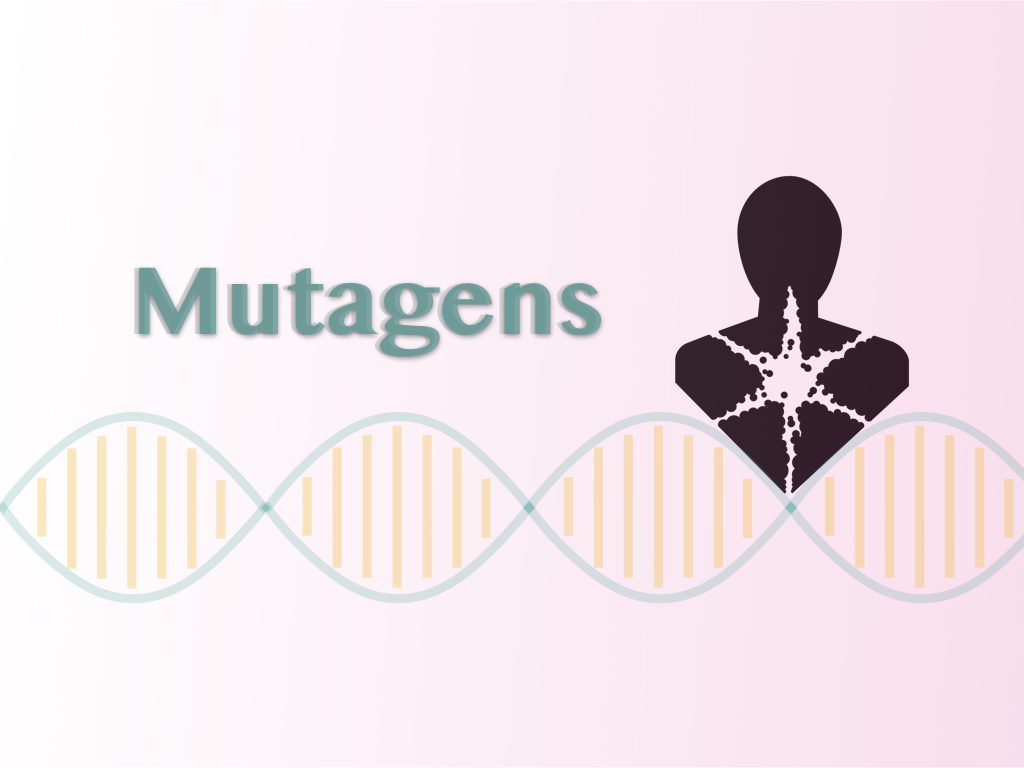“Mutagen is a physical, chemical or biological agent that causes mutation by altering the genetic material which possibly results in the disease condition.”
In a simple language, we can say that mutagens are the agents that damage our genetic material, usually DNA and result in genetic abnormalities– either inherited or non-inherited.
Or
Anything that causes mutations is known as mutagens.
In genetics, mutagen-induced changes are known as mutation. The mutations are categorized under two broader categories; gene mutations and chromosomal mutations.
The present topic is very important, in order to understand the mechanism of how genetic mutations originate in nature.
Further to this, we will understand how different chemical, physical or biological agents affect our DNA or genetic material by altering the base sequences or the expression of a particular gene.
The common cause of any mutagen is cancer- uncontrolled growth of cells.
“A change in the genotype that influence or altered related phenotype is known as a mutation.”
Insertion, deletion, duplication, translocation, inversion are some of the common types of gene mutations that occur spontaneously in nature while trisomy, monosomy and numerical chromosomal abnormalities are some of the chromosomal abnormalities.
However, not all mutations emerge due to mutagens, some mutations arise spontaneously by error in replication, hydrolysis or recombination errors. In the present article, we will cover all the information on mutagens and their role in the development of the disease.
The content of the article is
- What are mutagens
- Definition of mutagens
- Types of mutagens
- Physical
- Radiation
- Heat
- Chemical
- Base analogs
- Alkylating agents
- intercalating agents
- Metal ions
- biological
- Viruses
- bacteria
- transposons
- Physical
- Effect of mutagens
- Conclusion
Key Topics:
What is mutagen?
I think it is better to start from the beginning,
So let’s start from the DNA,
DNA is a genetic material- a polynucleotide chain made up of the long chain of A, T, G, and C. The functional piece of DNA- a gene encodes a specific protein. If the sequence of a nucleotide within a gene is changed, the protein can not be formed or loss of function protein is formed.
Let’s take an example for that,
Suppose a gene “DNT” is a 1000 nucleotides long functional gene located on chromosome “Z” (just assume it, it is an example).
The DNT gene encodes a protein called “doughnut ?” which helps in the regulation of the cell cycle. Let say, it balances cell death and cell proliferation.
If a nucleotide “C” at position 10 is deleted, the DNT gene can’t form a protein. Thus the process of cell death and cell proliferation disturbs. And this will happen because of prolonged exposure to UV light.
The deletion of “C” is known as a mutation, the mutation results in cancer and the UV light is called a mutagen.
From this example, we can say, “due to the mutation delC10 in a gene DNT, a protein ‘doughnut’ can’t be formed- results in cancer, which is caused by prolonged exposure of mutagen UV light.” I think now you understand how mutagen causes mutations.
Some of the common mutagens are UV light, X- rays, ROS, Alkalyting agents and base analogs, etc. we will discuss each type of agent in the coming section of this article.
Definition of mutagen:
“Mutagens are the known agents either physical, chemical or biological causes mutations by altering the genotype or gene expression which results in genetic abnormality.”
In other words, we can say,
“Mutation caused by any agents is known as a mutagen.”
or
“Natural or artificial agents which change either structure or sequence of a gene or DNA are known as mutagens.”
Type of mutagens:
Three different types of common mutagens are observed in nature- physical agents, chemical agents and biological agents.
Physical agents:
- Heat and radiation
Chemical agents
- Base analogs
- Intercalating agents
- Alkylating agents
- Deaminating agents
- Metal ions
Biological agents
- Viruses
- Bacteria
- transposons
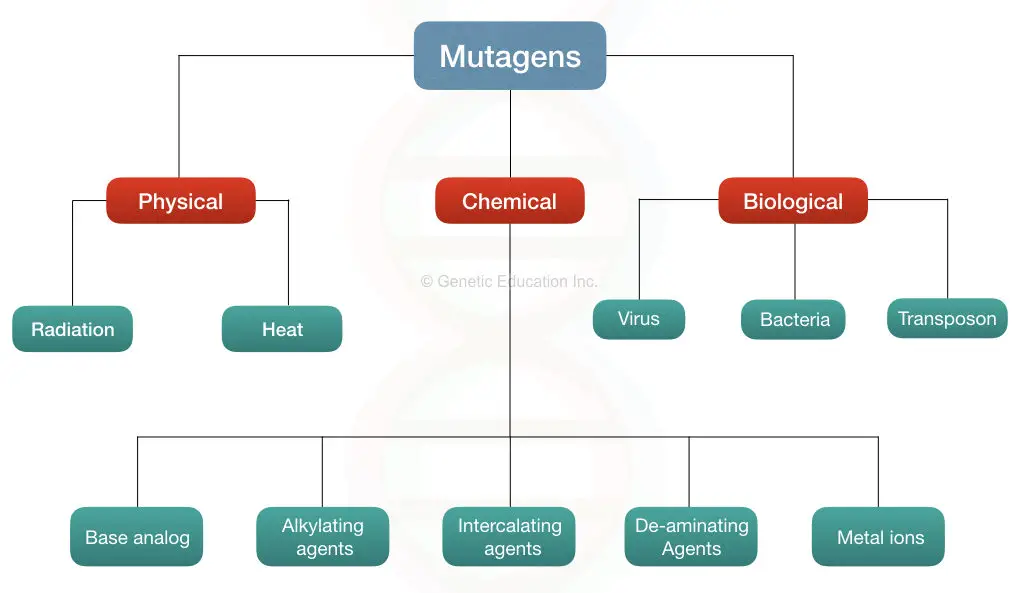
Physical agents:
Radiation:
Radiations are the first mutagenic agent reported in 1920. UV rays, X-rays, alpha rays, neutrons, and other ionizing and non-ionizing radiations are mutagenic.
Usually, radiation directly damages the DNA or nucleotide structure which might be either lethal or sub-lethal. Electromagnetic radiation is also one of the known mutagens that cause lethal or sub-lethal mutations (Kill the organism/cell or alter the function of the cell or protein or a gene).
One of the common types of radion- the iodizing radiation produces the free radicals that damage, not even the DNA but also proteins and lipids present in a cell.
The rapidly dividing cells are a prime target for ionizing radiations like X-rays, however, the severity of the damage depends on the dose of the radiation.
The radiation causes cross-linking of DNA or protein, chromosomal break, strand break or chromosomes loss, also, at the molecular level, it prompts deletion of bases or DNA strand breakages.
X-ray radiation:
X-rays are one of the most common types of ionizing radiation used in several medical practices for various purposes. However, the dose for that is very moderate. It is even used in sterilizing practices for destroying microorganisms.
At the molecular level, the lethal dose of X-ray (350-500 rems) breaks the phosphodiester bonds between the DNA and thus results in strand breakages.
It creates multiple strand breakage and results in the deletion of the portion of DNA. If the strand breakage occurs in both strands, it will become lethal to the cell.
UV-rays:
The UV-light is a non-ionizing type of radiation having less energy in it, used in the sterilization and decontamination process during the cell culture and microbiological experiments. The DNA and protein absorb UV light of 260 and 280nm, respectively.
The major causes of UV radiation are- base deletion, strand breakage, cross-linking and generation of nucleotide dimers.
The UV-light can be classified into three different categories:
UV-A: nearly visible range (320nm) causes pyrimidine dimers.
UV-B: (290-320nm) emitted by the sunlight. These UV rays are highly lethal to our DNA.
UV-C: (180-290nm) is one of the most energy-consuming forms of UV which is extremely lethal.
The UV-induced mutations are dimer formation such as thymine- thymine dimer and thymine- cytosine dimers. DImers also block replication and translation. If it remains unrepaired, it can cause serious health problems.
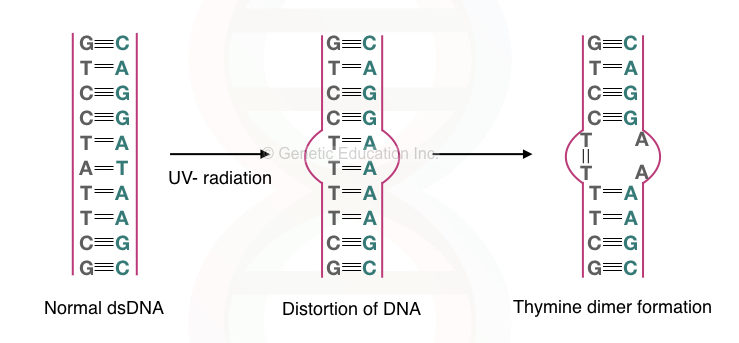
The formation of pyrimidine dimerization cause distortion in the structure of DNA and prevents the formation of replication fork during replication.
Heat:
Heat is another mutagen that provokes mutations in our DNA. when we heat the DNA, over a certain degree (>95°C), the DNA becomes denatured- two single-stranded DNA is generated from the dsDNA. Also, extreme heat also damages DNA and breaks the phosphodiester bonds too.
Chemical mutagens:
Chemicals are actually dangerous for the entire world. The first mutagenic effect of nitrogen mustard was reported by charlotte Auerbach in 1942.
(nitrogen mustard is a poisonous gas used during world war 1 and 2).
Base analogs:
The base analogs are chemicals similar to the bases of DNA- purine and pyrimidines or structurally resemble the DNA bases. Bromouracil and aminopurine are two common base analogs incorporated into DNA- instead of normal bases, during the process of replication.
The 5-bromouracil are artificially synthesized molecules- a base analog utilized in the genetic research which is incorporated in DNA in place of the thymine. Instead of the methyl group of the thymine, the bromouracil contains the Br group- which is similar to the thymine.
It pairs with the adenine like the thymine and produces the mutation. See the image below,
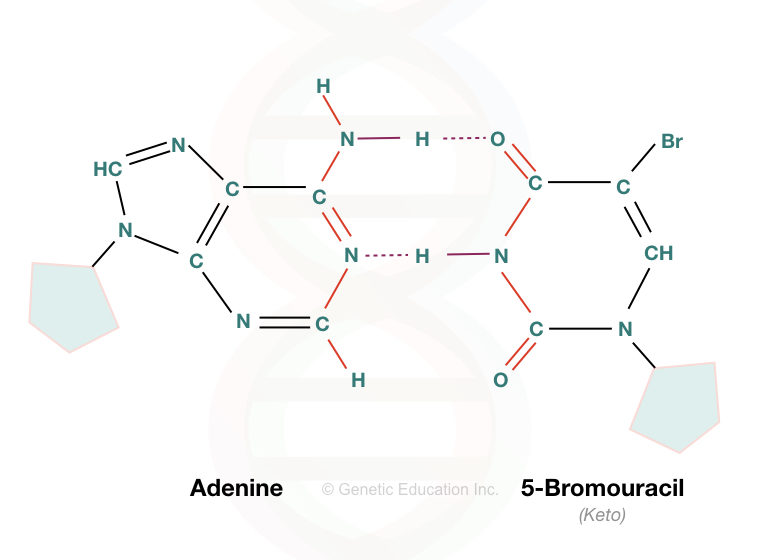
The mechanism of 5-BU action is quite interesting. During the replication, instead of thymine, it generates the guanine which pairs with the cytosine. See the image below,
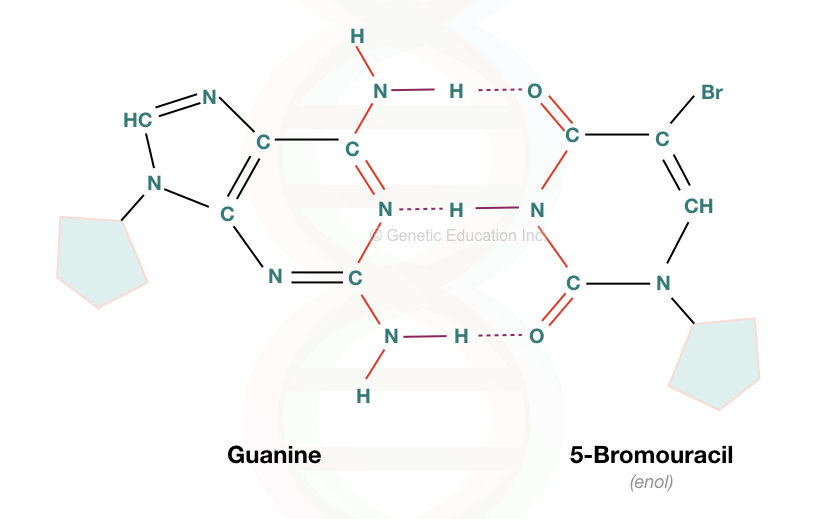
Thus the TA base pair is replaced by the GC base pair at the end of the replication and this happens because of the tautomeric shift of 5-BU from ‘enol’ to ‘keto’ form. The entire mechanism of it is shown in the figure below,
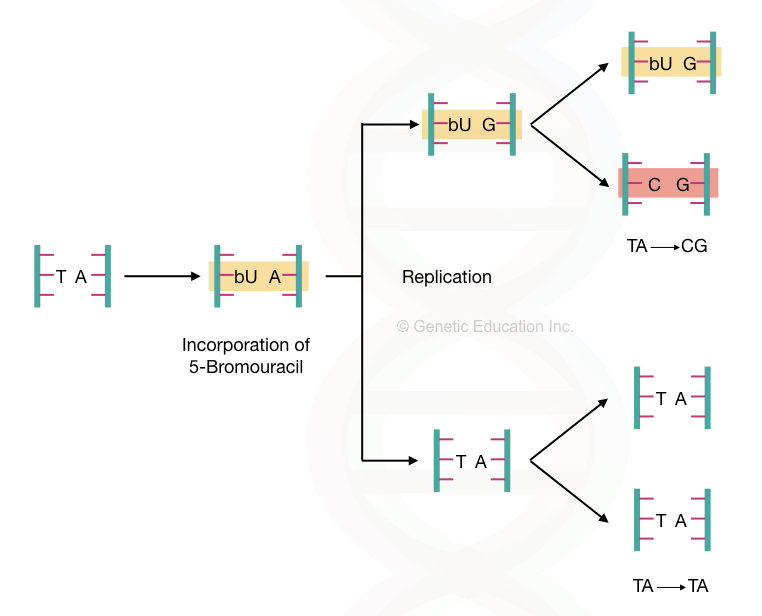
Aminopurines:
Another base analog is AP or amino purine which is similar to the adenine and can pair with either T or C, although pairing with C is less frequent. It can also cause AT to GC or GC to AT transition during the replication.
Alkylating agents:
Ethylnitrosourea, mustard gas and vinyl chloride are common alkylating agents that add alkyl group to the DNA and damages it. The agents induce base-pairing errors by increasing ionization and producing gaps in the DNA strand.
The alkylated purine bases are removed by the phenomenon called depurination, although depurination is not mutagenic and can be repaired by the DNA repair pathway.
Common alkylating agents:
- Methylhydrazine
- Temozolomide
- Dacarbazine
- Busulfan
- Thio-TEPA
- Carmustine
- lomustine
- Dimethyl sulfate
- Ethyl ethane sulfate
“When nitrities (food preservatives) added to smoked meat, it forms nitrosamine like mutagen that can break DNA or creates DNA cross-linking.”
Intercalating agents:
Does anything strike in your mind?
Our EtBr- ethidium bromide used during the agarose gel electrophoresis is one of the intercalating agents. Other intercalating agents like proflavine, acridine orange, or daunorubicin are operated by the same mechanism alike the EtBr.
The molecules intercalate between the bases of DNA and disrupt its structure. If it is incorporated during the replication, it can cause frameshift mutation. It may also block transcription.
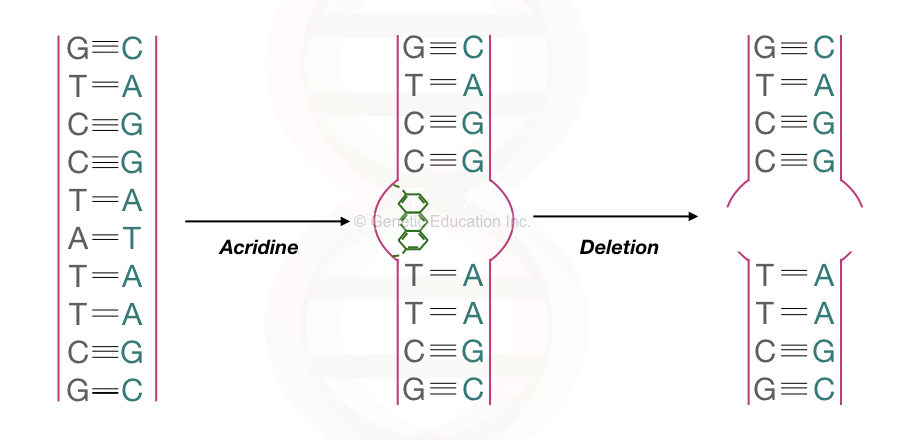
The intercalating agents either cause deletion or insertion and disrupts the DNA structure.
Metal ions:
Metal ions are also dangerous to our DNA as it acts in varieties of different ways. Nickel, chromium, cobalt, cadmium, arsenic, chromium and iron are some of the common metal ions that cause mutations.
The metal ions work by producing ROS (reactive oxygen species), hindering the DNA repair pathway, causing DNA hypermethylation or may directly damages the DNA.
Other chemical mutagens:
ROS- reactive oxygen species, benzene, synthetic rubber and rubber products, sodium azide, aromatic amines, alkaloids, deaminating agents and PAH (Polycyclic aromatic hydrocarbons) are other mutagens that create different mutations.

Biological agents:
Viruses, bacteria and transposon (non-coding DNA sequence) are biological mutagens.
Virus: We all know about HIV right! A causative agent of AIDS. Viruses are common mutagens that are well known to us and create lethal health issues.
Viruses insert their DNA into our genome and disrupt the normal function of DNA or genes. Once it inserts DNA, the DNA is replicated, transcribed and translated into viral protein instead of our own protein. Mature viral particle forms in a cell.
Bacteria: Some bacteria are also dangerous for our DNA- cause inflammation. It provokes DNA damage and DNA breakage.
Transposons: Less known biological mutagens are transposons. The transposons are non-coding DNA sequences, jump from one place to another place in a genome and influence the function of genes.
Unlike the viral DNA, the transposons are our own DNA believed to be originated from the retroviruses. We have covered an entire series on transposons and transposable elements. Please read it here.
- Category: Transposons.
Effect of mutagens:
The mutagens are genotoxic- harmful to our DNA in many ways, some directly affect the DNA some indirectly. And therefore, the exact effect of each mutagen is still unknown to us.
At the chromosomal level, the mutagens can alter the structure or number of chromosomes. Deletion, duplication, insertion, translocation, monosomy and nondisjunction are some of the chromosomal abnormalities produced by mutagens.
The mutagens also affect or dysregulate the molecular central dogma process- replication, transcription and translation. At the molecular level, the mutagens create different gene mutations results in loss of function, altered function or non-functional protein.
It also alters the codon, deletes bases, alters bases, breaks hydrogen bonds or phosphodiester bonds and changes gene expression. Some mutagens dysregulate cell proliferation and cell death process and thus cause cancer, those are called carcinogens.
Biological mutagens slower down the DNA repair or DNA synthesis process. Some of the common types of mutagens based on their effect are enlisted here:
Teratogens: teratogens are the class of mutagens that causes congenital malformations. X-rays, valproate and toxoplasma are common physicals, chemical and biological teratogens, respectively.
Carcinogens: The carcinogens are the class of mutagens that induces tumor formation and thus cause cancer. A wide variety of agents are categorized as carcinogens. X-rays/ UV-rays, Aflatoxins and retroviruses are common physicals, chemical and biological carcinogens, respectively.
Clastogens: Clastogens are the class of mutagens responsible for chromosomal- breakage, deletion, duplication and rearrangements. UV-rays, Bleomycins and HIV viruses are common types of physical, chemical, and biological clastogens, respectively.
Other non-specific mutagens: other unclassified mutagens are responsible for DNA damage and non-functioning of the DNA repair pathway. X-rays/heat, innumerable and toxoplasma are several non-specific mutagens.
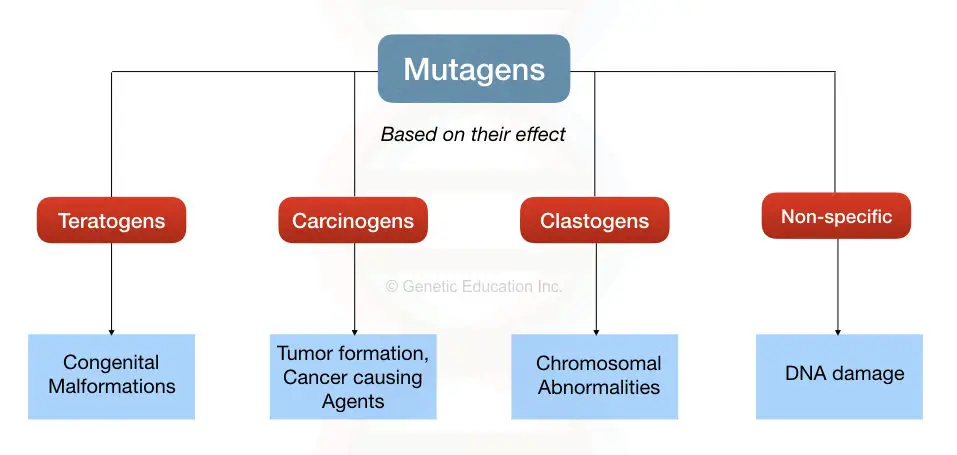
Mutagens are useful…
Now, this is something interesting, scientists are using various physical, chemical or biological mutagens for various purposes. For example, an EtBr is used as an intercalating dye during agarose gel electrophoresis. It emits fluorescent and the DNA bands can be visualized on a gel.
The heat method is used during the polymerase chain reaction for the denaturation of DNA. This facilitates single-stranded DNA for various applications. The UV-rays are utilized for decontamination or sterilization processes in genetics as well as microbiology. The UV light destroys all the bacteria or viruses present in a culture room or laminar hood.
Carcinogens and teratogens are used in cancer research.
Our transposons are used as a vehicle for transferring a gene of interest at a particular location in a genome. Thus it is used in gene therapy experiments.
Conclusion:
Thanks to our DNA repair system, almost all abnormal DNA mutations are repaired by it.
By adopting a healthy lifestyle we can save our DNA from the harmful effect of mutagens. For example, use sun scream while coming out in sunlight. Eat healthy food and stay away from unnecessary radiation.
Mutagens are harmful, but not always. Some mutations are also beneficial to us, however, those are rare. In fact, different phenotypes for our survival are originated due to different mutations but those are not originated from the mutagens, possibly.
Quiz:
(A) Which one is not a mutagen?
- teratogen
- carcinogen
- clastogen
- antigen
(B) Which one is an intercalating agent?
- EtBr
- BPB
- Bromouridine
- Aminopurine
(C) UV light is also used for____
- Cancer therapy
- Sterilization
- PCR
- Gene therapy
(D) Base analogs are______
- similar to phosphate
- similar to DNA
- similar to purines or pyrimidines
- similar to deoxy sugar
Answers: (A): 4- Antigen. (B): 1- EtBr. (C): 2- sterilization. (D): 3- similar to purines and pyrimides.
Sources:
T. J. Schrader. Mutagens, Encyclopedia of Food Science and Nutrition. 2003; 2:4059-67.
